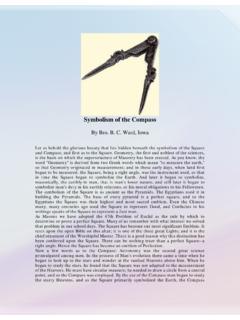Transcription of Symbolism of the Sword - Grand Lodge Bet-El
1 Symbolism of the Sword Cultural Traditions and Sword Rituals Throughout time swords and daggers have been ingrained into the cultures and rituals of many historic eras creating traditions involving honor, and others which were more humiliating or deadly. Swords were a big part of everyday life just as cell phones are today. Some of the better known Sword traditions include: 'On my honor': Taking an oath of honor upon your Sword (pledge, swear). This was done by either gripping the handle of your own Sword (remaining in the scabbard), or by kissing the blade of the other persons Sword (typically a person of royalty). If such an oath was broken, the individual was to be executed by his own Sword . 'Dubbing' a Knight: This was the formal process of conferring knighthood upon an individual. The ceremony could be very formal with lots of pageantry as the 'adoubement' of the knight occurred.
2 The giving of 'adoubs' (core part of the ceremony) was the process of giving a knight his new armor and weapons. Presenting the Sword was the central act of adoubement often performed by royalty (or another knight) quoting traditional rhetoric while tapping ones shoulders with a Sword . (Historical evidence shows the majority of knights were dubbed on the battle field with little formality.) Kiss the Sword : The highest form of confirming an oath or ones loyalty. Sword and Bride: At marriages, a Sword would be used to represent a bridegroom in his absence. Surrendering your Sword : To yield your weapon to the requestor as part of submitting or being placed under arrest. Victors required the conquered to submit their Sword which was then broken in a formal ceremony of degradation. This is especially true for internal military expulsions since a Sword was the mark of an officer and a gentleman.
3 Rite of passage: The Sword is the symbol of Knighthood (or of being a 'warrior' in more primitive periods) and when ceremonially presented for the first time, the recipient was confirmed to a higher social standing. To qualify for this opportunity, it often required proof of a specific bloodline (heritage) and training, but in special situations these formalities were omitted. Put to the Sword : To be executed. Fall upon your Sword : To commit suicide. Fell by the Sword : To have been killed in battle. Sentenced to 'The Sword ' (or 'Put to the Block'): Death by Sword execution, specifically beheading. (The guillotine eventually replaced a Sword in this capacity during the Middle Ages.) Blood Oath (Blood Brothers): Pirates and many cultures were known to use blood to confirm solemn oaths. The most common ceremony involved two people in an oath taking their own daggers, slicing open one of their own palms and then clasping the other person's cut palm allowing the blood of both people to mix together.
4 With their blood being united, so were their souls - upon penalty of death (if the oath was broken). Dueling: A process of dispute resolution typically between two people which involves fighting with 'weapons of choice' until the offending party yields and makes restitutions, or someone gets killed. Although swords and daggers were very common, exciting stories of dueling with pistols overshadowed their memory. Fencing: The sport of swordsmanship. Swords used include the rapier, foil and saber. The Sword used to play an important role in Freemasonry, and still does so in many of the so-called "higher" degrees. In ancient times, it was a regular part of the dressing of a gentleman, but Masons were required to leave their swords in the Tyler's room before entering a Lodge . Its importance can be seen that even today, many Grand Lodges still appoint a "Swords Bearer".
5 Why is the Sword so important? The Sword has a classic duality to it. In most cultures, any weapon symbolizes power - but this power can go both ways. On the one hand it kills and destroys, yet on the other it protects and is a central symbol for chivalry. No man was considered a true knight unless he was presented with his Sword in an often elaborate ceremony. The Japanese Samurai went one step further, considering the Sword to be their own spirit, and it was never to leave one's side. For this reason, even today, forgers of swords go through an elaborate ceremony before, during and after forging a new blade. The Knights Templars swore that they would never draw their swords unless convinced of the justice of the cause in which they were engaged, nor to sheathe it until their enemies were subdued. Many swords, especially those from Spain, often had the following engraved on them "No me saques sin rason.
6 No me embaines sin honor"; meaning Do not draw me without justice, do not sheathe me without honor. The Tyler's Sword should traditionally be one with a "wavy" blade, to symbolize the flaming Sword that was placed at the east of the garden of Eden, which turned every way to keep the way of the tree of life (Genesis 3:24). It should also never be sheathed, as it is the Tyler's duty to keep off, at all times, "Cowan s and eavesdroppers." An example of a traditional Tyler's Sword Light: Sword is also closely linked to light. Swords glitter, and the Crusaders used to call them fragments of the Cross of Light. The Japanese Sword sacred to the Emperor originated in lightning, when the storm-god Susa no O kills an eight-headed snake, and pulls from its tail the Sword called Ame no murakomo no tsurugi. This miraculous Sword was given by the sun goddess Amaterasu to her grandson Ninigi when he descended to earth to become ruler of Japan, thus establishing the divine link between the imperial house and the sun.
7 The Vedic sacrificial Sword originated by Indra s thunderbolt. Lightning is associated with water, and hence another link between the fire- Sword -water that Wor. Conseil refers to. When God drove Adam and Eve from Paradise, he sends Cherubims carrying flaming swords. These swords threw off lightning bolts (Genesis 3:24). Fire: In alchemy , the fire in the furnace is called The Philosopher s Sword . The Anglo-Saxon word for Sword was seax, meaning the fire of the great fire , the Italian word is spada, or sepada, meaning the fire of the shining Father. Duality: The Sword is the most obvious symbol of a warrior, but can be taken in two ways: Destructive - for purposes of killing and the like Positive - Defending justice, destroying injustice and the like This is often why a Sword is often symbolically double-edged Furthermore, we have seen the Sword being associated with fire which creates it, and war.
8 One of the most common symbols of war is also the planet Mars, also called the planet of fire because of its color. However, a Sword can also be cold because of its bare metal ? hence another duality. The Connetable (Constable in English) was one of the original five officers of the royal household: the Seneschals, Chambray, Connetable, Bouteiller and Chancelier. The office is a very ancient one, since it existed in the late Roman Empire (comes stabuli, count of the stable). After the abolition of the office of Senechal in 1191, the Connetable was the most important officer in the army. His insignia of office was the straight Sword , which represented the king's Sword whose care was his. He carried before the king during the coronation ceremony. The same Sword appears, held by a hand from a cloud, on both sides of his coat of arms. Connetable: Grand Ecuyer This office became a Great Officer under Henri III.
9 He was customarily called "Monsieur le Grand ." The insignia consists of the king's Sword in its sheath and with the belt. Note that the coat-of-arms of the Connetable, who works for the King, is a naked Sword , whereas the coat-of-arms of the Grand Ecuyer, who works with the King, is sheathed. FREEMASONRY 33 - Sovereign Grand Inspector General hirty Third Degree: The last and final degree of the Ancient and Accepted Scottish Rite Freemasonry is called "Sovereign Grand Inspector General." This degree is generally defined as the administrative degree of the order. The meetings are called Supreme Council . The jewel is a black double headed eagle with golden beaks and claws, holding in the latter a gold Sword .







